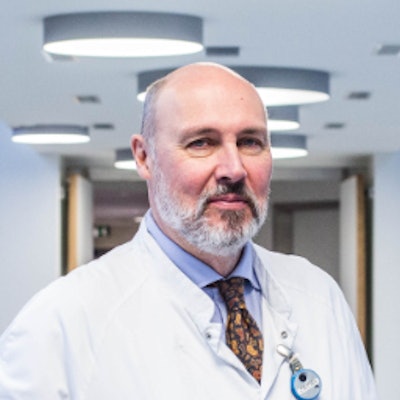
A year on from the CT contrast media supply problems that caused severe disruption to medical imaging in many parts of the world, ESR Past President Prof. Paul Parizel, PhD, and his colleagues have presented the findings of their investigation into the crisis.
 Prof. Paul Parizel, PhD.
Prof. Paul Parizel, PhD.In April 2022, the COVID-19 pandemic caused a sudden and abrupt decrease in the production of iodine-based contrast media. Subsequent difficulties in the supply chain led to a substantial and unanticipated scarcity in this resource in Australia.
Parizel, who is the David Hartley chair of radiology at the University of Western Australia in Perth, said the incident raises some really tough questions:
- Why was the shortage so much more severe in Australia?
- Why were European healthcare systems so much better at protecting their patients from this shortfall?
- Why are Australia and regions of North America so heavily reliant on one single manufacturer of contrast media, with a single production unit in Shanghai?
- Why does Australia have such an appetite for iohexol, which is one of the oldest (and arguably the cheapest) nonionic contrast agents?
"Other questions are obviously about the far-reaching and multifarious implications for patient care of this calamity," Parizel told AuntMinnieEurope.com. "In patients with pulmonary emboli and stroke, missed diagnosis results in missed treatment opportunities, potentially leading to increased morbidity, mortality, and additional cost to the healthcare system. We may never know the true long-term impact on patients' lives."
The CT contrast media shortage is a prime example of what happens when centralized purchasing decisions are disconnected from the day-to-day needs of healthcare professionals, he continued. "In public hospital systems, all too often, strategic purchasing decisions are made 'centrally' by committees who are instructed to choose the product with the lowest price.”
Medical practitioners have too little power to directly influence these processes, according to Parizel, who has recently been elected to be chair of the Scientific Advisory Committee (SAC) for the National Imaging Facility (NIF) for Australia. Yet even though they cannot choose their preferred tools of the trade, medical professionals must assume responsibility for any adverse effects and deal with consequences of decisions made by others, he said.
Learning the important lessons
Parizel and his colleagues in Perth have explored the impact of this shortage on the delivery of healthcare in Western Australia. The group published its findings on 17 May in the Journal of Medical Imaging and Radiation Oncology (JMIRO). The lead author was Dr. Giles Kisby, a first-year radiology registrar.
Parizel thinks these are the main lessons to be learned:
- Build a redundancy in the supply chain through contracts with multiple manufacturers and compel manufacturers to keep a buffer supply of 'safety stock' in-country (for further details, see page 2 of the JMIRO editorial by Parizel and Prof. Carlo Mallio from Rome posted on 26 April).
- Encourage healthcare organizations to take a critical look at their tendering process. "Contrast agents are not a mere commodity that can be centrally purchased without a deep understanding of the physicochemical and clinical properties of these products, or the vulnerability of the supply chain," said Parizel.
- Remember that not all benefits and costs can be understood in purely financial terms. Adverse reactions to contrast media have considerable clinical as well as economic costs. "In the end, the cheapest agent is not always the best, not for the patients, and not for the healthcare system."
- The tender evaluation committee must be heavily weighted towards the end users of the product in the organization (e.g., radiologists, cardiologists, medical imaging technologists, nurses) since they have the know-how and assume full responsibility in case of adverse effects and complications. Therefore, these professionals must be empowered to make operational and tactical decisions, in the best interest of the patients they serve, he concludes.



















